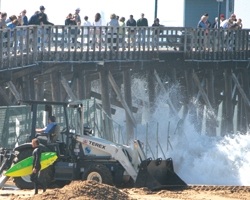
An extreme high tide and large winter waves combined to cause ocean water to rush up over the sand berm on the south side of the Seal Beach Pier on Sunday morning.
The tide reached its peak at about 9:20 a.m. and drew a crowd of curious spectators along with surfers who took advantage of the large swell at the beach. Some said they expected the waves to be larger.
According to David Carmany, Seal Beach city manager, there was not any extensive damage to any of the homes along the boardwalk where water came close to many of the properties.
However, by Sunday evening, the surf had died down with only slight flooding.
Authorities said the high surf and high tide are unrelated to the Chilean earthquake.
Seal Beach resident Kelley Barton was as the Seal Beach Pier at 8 a.m. to drop off her son Trevor, a surfer.
“By then the water was high in both parking lots,” she said. “I went home to get my camera and when I came back, a long boarder was standing on the beach with his board snapped in half. Lots of surfers were out.”
Barton described what she called “Lake Seal,” with the water on the sand, stretching from the Pier to First Street on the north side and from the Pier almost to the end of the boardwalk on the south side.
“People were wading through it to go out and surf or boogie board,” Barton said. “The pier was packed with people. I heard later some of the surfers and boogie boarders were shocked when they finally got out of the water and found the insides of the cars full of water.”
The surf also caused flooding on Pacific Coast Highway in Sunset Beach on Sunday morning and the California Highway Patrol closed a two-mile stretch between Warner Avenue and Anderson Street.
Carmany said Seal Beach seemed to have “dodged a bullet,” avoiding more extensive damage.
According to Seal Beach Chief Lifeguard Joe Bailey, city crew were a big help by cutting open a channel to let water drain from the beach back into the ocean.
“It’s the first time I can remember the ocean water going over the berm,” Bailey said.
Carmany said the city spent about $1 million this year to build a protective sand wall in front of the homes on the boardwalk and to replenish the sand that is lost each year to erosion.
“We put in about 90,000 cubic yards of sand to make up for sand we had lost,” Carmany said. “It could have been a lot worse.”
By Monday afternoon, most of the water that had rushed over the beach had dissipated.



